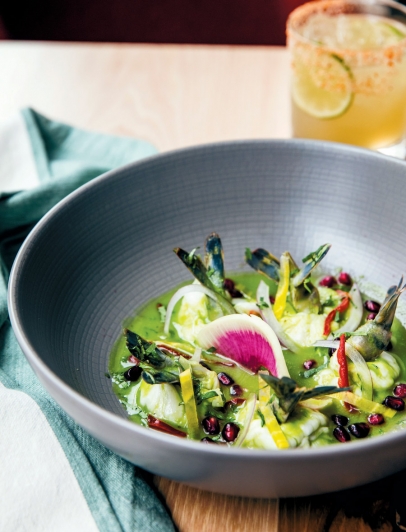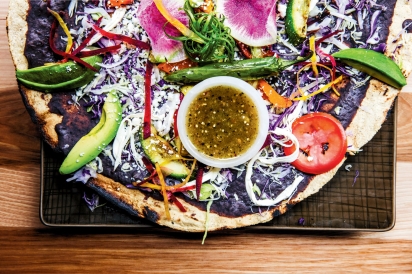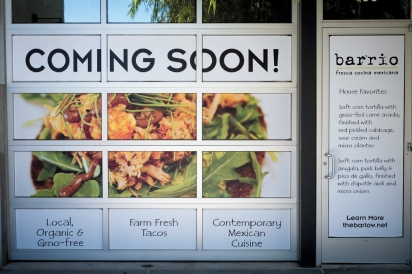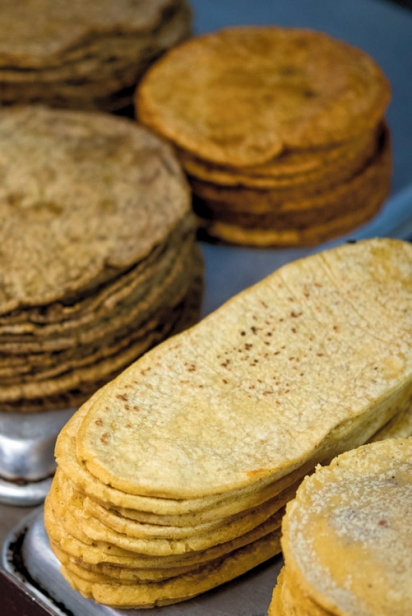Mole is The Tie That Binds
A TALE OF TWO MEXICAN-AMERICAN FAMILIES BUILDING LOCAL BUSINESSES ON THE ANCIENT TRADITION
7 MOLES FOR 7 SIBLINGS
To understand the entwined histories of Mexico and the United States would take more than the space this article allows, but one significant chapter is what is commonly referred to as the bracero program, an arrangement between the governments of both countries that encouraged millions of Mexican citizens to come north for short-term, mostly agricultural, labor contracts. The program was formally known as the Mexican Farm Worker Program.
The bracero program was introduced at a time when growers in California and elsewhere were worried about labor shortages in low-paid jobs such as agriculture during and after World War II. It lasted until the early 1960s.
Octavio Diaz, who owns and operates Agave Restaurant and Tequila Bar in Healdsburg and Agave Uptown in Oakland, traces his American story to the days of the bracero. Diaz’s father, Francisco, followed in the footsteps of his father and brother and came to California to harvest wine grapes as a bracero, making his way from Mexico every year to work wherever his quick hands and strong back were needed. Other family members came, too, and Francisco’s brother, Fito Ramirez, eventually settled in Northern California.
Despite their time spent working in the U.S., and their eventual resettlement here, the Diaz and Ramirez family connections to their Oaxacan homeland remained strong. Family members from both sides of the border regularly reunited to celebrate special occasions. Ingredients and traditions from both sides of the border were mixed and mingled. The family brought wine grape seeds to Oaxaca and Mexican herbs and spices to California.
Chef Diaz, the oldest of seven siblings, came to California in 1989 as a young teenager under the sponsorship of his Uncle Fito and Fito’s Irish-American wife, Colleen. “I came by myself,” Diaz says. “I always wanted to come to California and I was determined to speak English within two years.” His siblings and parents followed.
Diaz’s warm smile and sunny personality radiate off of him, adding softness to his sturdy frame and creating a circle of positive energy around him. He is a natural for the hospitality business and it is no wonder that one of his former roles was what he calls “the fixer” at the Petaluma Sheraton. His instinct to make everyone who comes into his orbit a member of the family is highly prized in an industry where the quality of customer service can turn a dissatisfied client into a return guest.
In 2010, after years of working for others in the restaurant and hospitality business, Diaz was looking for something more. His brother Pedro had purchased El Farolito in Windsor, introducing the flavors and ingredients of Oaxaca to Sonoma County in a Cal-Mex format (burritos are an important menu item, for example). Diaz had an idea to open his own restaurant that would focus on mole, the mother of all Oaxacan sauces.
Mole, pronounced MO-lay, is derived from the Nahuatl, or ancient Aztec, word for sauce and it means simply that: sauce, not any particular type. Three Mexican states claim to have originated mole, including Oaxaca, where seven variations of mole make up the classic sauces of the region. Variations are infinite and vary by region, availability of ingredients and family tradition.
At a recent lunch at his Healdsburg restaurant, Octavio leaned over to his mom, Juana Ramirez, to ask what makes the mole of Santa Gertrudis, the Diaz’s hometown, unique. “Tomato,” she said. It is her mother Rufina’s mole recipe that Diaz and other family members make in their restaurant kitchens. “It’s our secret ingredient,” says Diaz, noting that his mom insisted on his sourcing authentic Oaxacan ingredients if he wanted to use her mole recipe for his new restaurant concept.
Oaxacan terroir and the Oaxacan foodshed are as unique as any in the world. It leaves an impression.
“People who have been to Oaxaca and have been exposed to the flavors of Oaxaca connect immediately to my food,” Diaz says. And for those who haven’t? “The mole recipe comes directly from my family, it is part of our heritage,”
Diaz says that staying close to his roots is his secret to restaurant success. He did not want to open Agave without Ramirez’s mole recipe. David Cranmer, Agave Uptown’s general manager who recently spent the day with Diaz and me learning about the family’s farms, restaurants and market, jokes, “Mom’s allowed to use the [mole] recipe. The boys are allowed to sell it.” And Ramirez can often be found in Agave’s kitchen, continuing the family tradition of molemaking as community event. Other than disclosing that it includes tomato, however, her recipe remains top secret.
Ramirez also helped Diaz start a Oaxacan-ingredient-focused garden at his new home in the Bennett Valley region of Rohnert Park. Bordering Matanzas Creek, the garden is in its nascent stages. Diaz spent most of the first part of 2017 shoring up the steep drop to the naturally flowing creek, creating a sturdy retaining wall to terrace his garden area while leaving the creek’s watershed and environment intact. Planting began this past spring.
Many of the starter plants, such as Oaxacan perejil, an extremely aromatic parsley variant, come from Uncle Fito’s farm in Penngrove. Other Oaxacan natives include pepino, which in flavor is said to resemble a cross between honeydew melon and cucumber, as well as epazote and yerba santa.
Spanish explorers gave the name yerba santa, or “holy herb,” to the resinous plant found in California’s redwood forests and throughout much of the American West and Mexico after learning of its medicinal qualities from native peoples. It is a key ingredient in mole verde (green mole), one of the seven classic moles, and has a character that my European-centric palate found closest to anise or, perhaps, some stronger basil varietals. Yerba santa is akin to mint—once you plant it in your garden, it is yours forever: Its woody rhizomes shoot off exponentially, and care must be taken to prevent it from expanding into all available real estate. Diaz’s yerba santa, already grown to substantial proportions, was originally sourced from his mother’s Healdsburg garden.
“Talk about immigration,” laughs Diaz, “yerba santa is an immigrant plant. It just takes over!”
Though Diaz focuses his restaurant menus on the cuisine of his family’s homeland of Oaxaca, it is his life’s work to build and embrace his current community. One way he achieves this is through working with neighbors and adjacent farms to build a uniquely Californian foodshed. He learned how to make agua fresca from a pineapple guava plant (native to the South American highlands but widely planted in Northern California). He fell in love with figs after experiencing them at a friend’s orchard in Windsor and now incorporates them into his cooking when they are in season. Most of Diaz’s extended family is involved in food, one way or another. His wife, Nancy’s, family runs a farm in Napa. His brother Pedro oversees El Farolito in Windsor and the latest El Farolito location in Healdsburg. With Diaz spending more time at the new Agave Uptown, brother Gonzalo oversees operations at the Healdsburg location. Diaz’s youngest brother, Francisco, runs Casa del Mole, a small market and butcher shop in Healdsburg. “It’s the mole that keeps us together,” says Diaz.
And the Diaz family’s food empire shows no signs of slowing. Octavio is working with the Kapor Center for Social Impact in Oakland on plans to expand into a packaged food business. He also says he would like to develop a mole ice cream. Then there’s the small café inside Casa del Mole. Called Rufina’s Kitchen, the restaurant-within-a-store offers mole (over chicken or pork), de acuerdo, as well as a menudo so popular it sells out well before noon each Sunday. At press time, Octavio was on track to open his second Healdsburg location, Kitchen 335, at the end of the summer. The chef has tapped Rodrigo Mendoza to be the executive chef of the restaurant that will offer an international menu.
All told, the family employs around 210 people, building community and educating people about the ingredients and flavors of Oaxaca. For Diaz, this is exactly how it should be.
“The number one thing my parents taught me was gratitude,” says Diaz, who became a citizen in 2005. As a human conduit for Oaxacan cuisine made in America, Diaz—and the extended Diaz-Ramirez family—have given themselves to furthering our understanding of this ancient cuisine.
BARRIO MARIN AND BARRIO FRESCA COCINA MEXICANA: FINE DINING REQUIRES NO WHITE TABLECLOTH
Mole is also at the heart of Carlos Rosas’ immigrant story. Rosas, who owns and operates the Barrio Marin booth at the Marin Civic Center Farmers’ Market on Thursdays and Sundays, and the soon-to-open Barrio Fresca Cocina Mexicana at The Barlow in Sebastopol, was raised in San Luis Potosi, north of Mexico City. His restaurant life began when he was 11 and his mother married the owner of a taco stand. Not long after, Rosas went to work at the stand, learning every aspect of the business.
While working as a prep cook and dishwasher, he dreamed of being a highway patrolman when he grew up. That dream came to a halt when a serious injury, received while working as a bodyguard for a local businessman, led him to fear for his personal safety. Realizing the danger of his situation, Rosas called a cousin in San Francisco who agreed to help him come to California.
Out of harm’s way, Rosas soon found employment again in the restaurant industry, working as a bar back and busser at San Francisco’s iconic Stars before moving on to be the first Latino runner at Traci Des Jardins’s Jardinière. At various points in his career, Rosas worked three jobs simultaneously. His resume includes many of the Bay Area’s most popular dining destinations, including Zuni Café, Kokkari, Slanted Door and Des Jardins’s Mexican venture, Mijita, among others. There, he learned the workings of rapid-fire kitchens (how to turn out 300 lunches between noon and 1:30 at Kokkari, for example), as well as the infinite details involved in fine dining.
Rosas was the food and beverage coordinator at Sausalito’s Cavallo Point when the restaurant earned its first Michelin star, a high-water mark, but still Rosas was ready for a change. But to what? In all that time in restaurants, he had never worked as a chef. Then he met a customer who changed his life. “She asked me ‘Why not try for a booth at the farmers’ market?’” Rosas’ wife and operations manager, Mayra, who also owns a hair salon in Fairfax, set up a test dinner for friends and clients at her shop. “The guests that night immediately recognized Carlos’s talent,” says Mayra.
Rosas, however, still had lessons to learn. Seriously overweight at the time, he became very ill in 2012. “The problems were a direct result of his weight,” says Mayra. Getting the message, he changed his lifestyle and lost over 100 pounds. Rosas says he learned about the connection between organic foods and health and, using what he learned at Mijita along with words of wisdom from his mom, he taught himself how to remake the Mexican foods he loved, but healthier. He learned about non-GMO corn and where to source non-GMO masa. He studied his mom’s mole recipe.
Scoring a spot at the local farmers’ market, however, was not easy. Competition for a space at the popular Sunday and Thursday markets in San Rafael was fierce and quality standards very high. The Agricultural Institute of Marin organization, which operates the markets, required Rosas to do a try-out after he submitted his application. “He was very nervous,” Mayra says. “He treated it like it he was trying out for a high-end restaurant.”
The tasting panel clearly liked what they were served, and Rosas opened his Barrio Marin booth at the markets in 2013. “We did 45 lunches at our first farmers’ market,” says Rosas. “Now we do 400 at the Sunday market.”
When Rosas’ stepfather passed away in 2006, the chef brought his mom to California to be his sous chef. Originally from Oaxaca, “she makes a great mole,” says Rosas. But mole—its character and tradition—was the source of their biggest fight. “She had been doing it one way for 50 years,” says Rosas. “But I wanted people to taste each of the ingredients,” he explained of his tinkering with her recipe. “When mom tasted the new mole, it brought tears to her eyes,” says Mayra. “She said ‘Mijo, I’m sorry. The kitchen is yours.’”
The Rosas family will soon have another kitchen under their direction. After years of looking for a great location, they found a home at The Barlow in Sebastopol. “We wanted a seated restaurant, where we can serve wine and mezcal. And to show people that Mexico is not just mariachis and tequila,” says Rosas, “but also poetry and art and opera.” (Though who doesn’t love a good mariachi?) If all goes well, Barrio Fresca Cocina Mexicana at The Barlow will be open by Labor Day. Ask for the mole.









